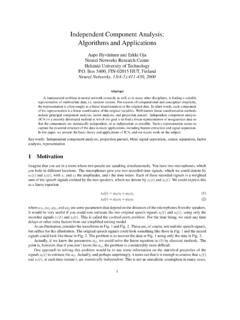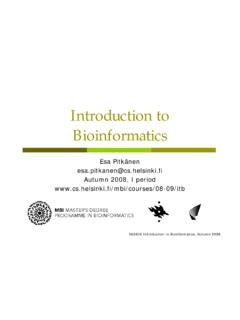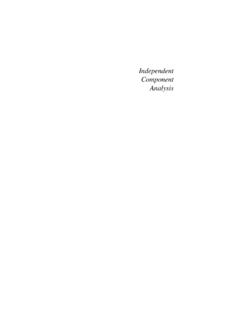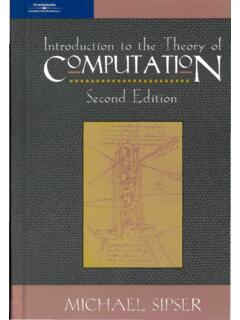Transcription of BASICS ON MOLECULAR BIOLOGY - University of Helsinki
1 BASICS ON MOLECULAR BIOLOGYBASICS ON MOLECULAR BIOLOGY Cell DNA RNA protein Sequencing methods arising questions for handling the data, making sense of it next two week lectures: sequence alignment and genomeassembly2 Cells Fundamental working units of every living system. Every organism is composed of one of two radically different types of cells: prokaryoticcells eukaryoticcells which have DNA inside anucleus. ProkaryotesandEukaryotesare descended from primitive cells and the results billion years of and Eukaryotes According to the most recentevidence, there are threemain branches to the tree oflife Prokaryotes include Archaea( ancient ones ) and bacteria Eukaryotes are kingdomEukarya and includes plants,animals, fungi and certainalgaeLecture.
2 Phylogenetic trees,this topic in more detail4 All Cells have common Cycles Born, eat, replicate, and die5 Common features of organisms Chemical energy is stored in ATP Genetic information is encoded by DNA Information is transcribed into RNA There is acommon triplet genetic code some variations are known, however Translation into proteins involves ribosomes Shared metabolic pathways Similar proteins among diverse groups of organisms6 All Life depends on 3 critical molecules DNAs (Deoxyribonucleic acid) Hold information on how cell works RNAs (Ribonucleic acid) Act to transfer short pieces of information to different parts of cell Provide templates to synthesize into protein Proteins Form enzymes that send signals to other cells and regulate geneactivity Form body s major components7 DNA structure DNA has a double helix structurewhich is composed of sugar molecule phosphate group and a base (A,C,G,T) By convention, we read DNAstrings in direction oftranscription.
3 From 5 end to 3 end5 ATTTAGGCC 3 3 TAAATCCGG 5 8 DNA is contained in In eukaryotes, DNA is packed into linear chromosomes In prokaryotes, DNA is usually contained in a single, circularchromosome9 Human chromosomes Somatic cells (cells in all, exceptthe germline, tissues) in humanshave 2 pairs of 22 chromosomes+ XX (female) or XY (male) = totalof 46 chromosomes Germline cells have 22chromosomes + either X or Y =total of 23 chromosomesKaryogram of human male using Giemsa staining( )10 RNA RNA is similar to DNA chemically. It is usually only a single (hyamine) is replaced by U(racil) Several types of RNA exist for different functions in the linear and 3D view:11 DNA, RNA, and the Flow of InformationTranslationTranscriptionRepli cation The central dogma Is this true?
4 Denis Noble: The principles of Systems BIOLOGY illustrated using the virtual Proteins are polypeptides (stringsof amino acid residues) Represented using strings ofletters from an alphabet of 20 Typical length residuesUrease enzyme from Helicobacter pylori13 Amino DNA/RNA codes for protein? DNA alphabet contains fourletters but must specify protein,or polypeptide sequence of 20letters. Trinucleotides (triplets) allow 43=64 possible trinucleotides Triplets are also calledcodons15 Proteins 20 differentamino acids different chemical properties cause the protein chains to fold up into specificthree-dimensional structures that define their particular functions in the cell.
5 Proteins do all essential work for the cell build cellular structures digest nutrients execute metabolic functions mediate information flow within a cell and among cellular communities. Proteins work together with other proteins or nucleic acids as "molecularmachines" structures that fit together and function in highly specific, lock-and-key A gene is a union of genomic sequences encoding a coherent set ofpotentially overlapping functional products A DNA segment whose information is expressed either as an RNAmolecule or protein5 3 3 5 .. a t g a g t g g t a c t c a c c t ..(transcription)(translation)MSG ..(folding) & alleles A gene can have different variants The variants of the same gene are calledalleles5 3.
6 A t g a g t g g t a c t c a c c t .. 3 .. a t g a g t c g t a c t c a g c t .. can be found on both strands3 5 5 3 19 Exons and introns & splicing3 5 5 3 Introns are removed from RNA after transcriptionExonsExons are joined:This process is calledsplicing20 Alternative splicingA3 5 5 3 BCDifferentsplice variantsmay be Prokaryotes are typically haploid:they have a single (circular)chromosome DNA is usually inherited vertically(parent to daughter) Inheritance is clonal Descendants are faithful copiesof an ancestral DNA Variation is introduced viamutations, transposableelements, and horizontal transferof DNAC hromosome map ofS. dysenteriae, the nine ringsdescribe different properties of the and continuum of string manipulation Point mutation: substitution of a base.
7 => .. Deletion: removal of one or more contiguous bases(substring) .. => .. Insertion: insertion of a substring .. => .. : Sequence alignmentLecture: Genome rearrangements23 Genome sequencing & assembly DNA sequencing How do we obtain DNA sequence information from organisms? Genome assembly What is needed to put together DNA sequence information from sequencing? First statement of sequence assembly problem: Peltola, S derlund, Tarhio, Ukkonen: Algorithms for some string matchingproblems arising in MOLECULAR genetics. Proc. 9th IFIP World ComputerCongress, 198324?Recovery of shredded newspaper25 DNA sequencing DNA sequencing: resolving a nucleotide sequence (whole-genome or less) Many different methods developed Maxam-Gilbert method (1977) Sanger method (1977) High-throughput methods, next-generation methods26 Sanger sequencing.
8 Sequencing by synthesis A sequencing technique developed by 1977 Also calleddideoxy sequencing ADNA polymeraseis an enzymethat catalyzes DNA synthesis DNA polymerase needs aprimer Synthesis proceeds always in 5 ->3 direction In Sanger sequencing, chain-terminating dideoxynucleoside triphosphates (ddXTPs) are employed ddATP, ddCTP, ddGTP, ddTTPlack the 3 -OH tail of dXTPs A mixture of dXTPs with small amount of ddXTPsis given to DNA polymerase with DNA template and primer ddXTPs are given fluorescent labels When DNA polymerase encounters a ddXTP, the synthesiscannot proceed The process yields copied sequences of different lengths Each sequence is terminated by a labeled ddXTP27 Determining the sequence Sequences are sorted according tolength by capillary electrophoresis Fluorescent signals corresponding tolabels are registered Base calling: identifying which basecorresponds to each position in aread Non-trivial problem!
9 Output sequences frombase calling are calledreads28 Reads are short! Modern Sanger sequencers can produce quality reads up to ~750 bases1 Instruments provide you with a quality file for bases in reads, in addition toactual sequence data Compare the read length against the size of the human genome ( ) Reads have to beassembled!29 Problems Sanger sequencing error rate per base varies from 1% to 3%1 Repeats in DNA For example, ~300 base longsAlusequence repeated is over million times inhuman genome Repeats occur in different scales What happens if repeat length is longer than read length? Shortest superstring problem Find the shortest string that explains the reads Given a set of strings (reads), find a shortest string that contains all of them30 Sequence assembly and combination locks What is common with sequence assembly and opening keypad locks?
10 31 Whole-genome shotgun sequence Whole-genome shotgun sequence assemblystarts with a large sample ofgenomic is randomly partitioned intoinsertsof length > 500 are multiplied by cloning them intoa vectorwhich is used to is collected from bacteria and are assembled32 Assembly of reads with Overlap-Layout-Consensus algorithm Overlap Finding potentially overlapping reads Layout Finding the order of reads along DNA Consensus (Multiple alignment) Deriving the DNA sequence from the layout Next, the method is described at a very abstract level, skipping a lot of details33 Finding overlaps First, pairwise overlap alignment ofreads is resolved Reads can be from either DNA strand:Thereverse complementr* of eachread r has to be consideredacggagtccagtccgcgctt5 3 3 5.











